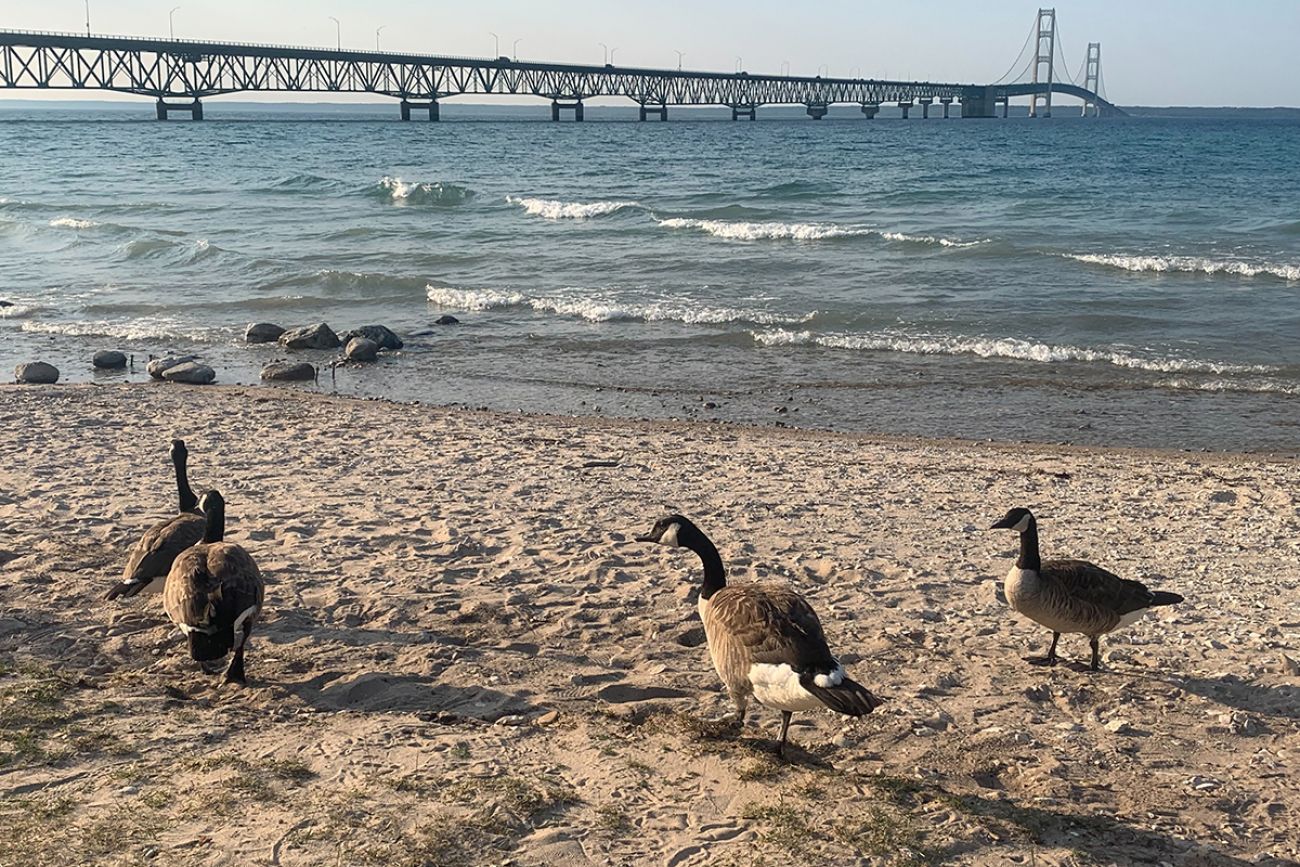
By Zahra Ahmad, Bridge Michigan
The Great Lakes News Collaborative includes Bridge Michigan; Circle of Blue; Great Lakes Now at Detroit Public Television; and Michigan Radio, Michigan’s NPR News Leader; who work together to bring audiences news and information about the impact of climate change, pollution, and aging infrastructure on the Great Lakes and drinking water. This independent journalism is supported by the Charles Stewart Mott Foundation. Find all the work HERE.
More Canada geese are becoming full-time Michigan residents, opting to stay in cities over the winter rather than flying in their v-formation further south.
Climate change is making Michigan’s winters milder, prompting some Canada geese to skip the trip south and take up residence on golf courses, lawns and parks.
While the overall goose population in the state is down, from 240,000 in 2019 to 200,000 this year, Barb Avers, a waterfowl and wetland specialist for the Department of Natural Resources, said human-goose conflicts are up.
That’s because as more birds choose to stay year-round, residents are more likely to complain about how much they poop, destroy crops or waddle in droves around parks.
“There are just so many more opportunities for Canada geese and people to interact,” Avers said.
The Great Lakes region is seeing higher annual average temperatures, making winters warmer and melting ice quicker. This has changed migratory trends among Canada geese and other waterfowl over the past 30 years, Avers said.
Canada geese are very adaptable. They were nearly wiped out by overhunting in Michigan in the early 1900s but bounced back after hunting rules were tightened and people started caring about habitat conservation, said Stephanie Beilke, senior manager of conservation science at Audubon Great Lakes.
“Specifically, people cared about protecting wetland habitats which (Canada geese) could forage during migration,” Beilke said.
Today, Canada geese and other waterfowl are among the few species whose populations are growing across North America despite habitat loss and warming temperatures.
Generally, Canada geese migrate in an iconic v-formation towards the southern U.S., flying up to 1,500 miles in just 24 hours in search of open water and food. They are foragers with a mainly vegetarian diet consisting of grass.
The black and white goose, which can grow up to 20 pounds, would then fly back to Michigan in the spring. However, Beilke said more geese that overwinter in the southern part of the U.S. are now more likely to arrive in Michigan sooner or stay later.
This is particularly apparent in the southern Lower Peninsula where there are plenty of dense, urban areas.
Beilke said that cities experience the urban heat island effect which occurs when cities replace natural land cover with concrete, buildings and other surfaces that absorb and retain heat. These areas are more likely to have open waters during mild winters, which Beilke says is what geese need to stay put.
“We’ve created this ideal habitat that the goose really likes, which ends up being a problem because people don’t want them around,” Beilke said. “The common complaint is that they just make a lot of poops.”
The increasing number of Canada geese staying over the winter is causing state parks “a lot of issues,” said Ron Olson, Michigan DNR Parks and Recreation Chief.
“Particularly in beach areas and heavily used parks where they like to congregate,” Olson said.
Canada geese like parks and golf courses for their manicured lawns, abundant open water and other resources they need to thrive. Olson said park workers are constantly picking up goose poop — the bird can produce up to two pounds of poop a day, which contribute to beach closings like those in Lake St. Clair because of high E. Coli bacteria concentrations.
According to Olson, parks spend between $3,000 and $4,000 annually trying to manage the goose conflicts using methods like rounding them up and relocating them or unleashing herd dogs to scare them off.
But despite parks’ best efforts to “scatter the geese so they go elsewhere,” Olson said the birds always come back.
“You can call any park system in the Midwest, and you’ll find there’s challenges with the goose populations that hover there,” Olson said.
The DNR has several methods to control goose populations. One is a nest and egg destruction program, where property owners can apply for a permit that lets them destroy the geese’s breeding grounds.
Another method is the goose round up program. Property owners can contract a company to remove the birds and relocate them.
But round-ups are not an effective long-term solution, according to the DNR: The geese, like in-laws, eventually seem to return.
The most effective method of controlling the population is hunting, said Avers, the waterfowl specialist.
Canada geese are migratory birds protected by federal law, but Michigan has the broadest possible hunting season, Avers said. The state’s hunting season stretches from Sept. 1 into early February in various parts of the state. Some specifically target geese, according to the DNR.
However, Michigan does not allow people to hunt with a firearm within 450 feet of an occupied building, dwelling, residence or cabin, making it nearly impossible to control the population in the cities.
“Many of these areas where human-goose conflicts occur, hunting just isn’t possible because of safety issues, so that counts that out,” Avers said.
Catch more news at Great Lakes Now:
Researchers race to understand what lies beneath the Great Lakes
On Isle Royale, fate of summer cabins pits nature against family history
Featured image: Canada geese are becoming resident birds in Michigan because of the state’s warmer climate. (Photo Credit: Joel Kurth/Bridge Michigan)




